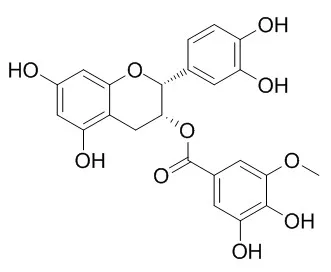| In vitro: |
| Nippon Shokuhin Kogyo Gakkaishi》 , 1999 , 46 (3) :138-147. | | HPLC Analysis of Catechins in Various Kinds of Green Teas Produced in Japan and Abroad[Reference: WebLink] |
METHODS AND RESULTS:
In Japanese green teas such as Matcha (powdered green tea or ceremony tea), high quality Sencha (Sencha : a ordinary Japanese green tea), medium Sencha, Bancha (coarse type green tea) and Hojicha (roasted green tea), the sum of four major catechins, i.e. (-)-epigallocatechin-3-gallate, (-)-epicatechin-3-gallate, (-)-epigallocatechin and (-)-epicatechin were dominant in the total catechin contents. In addition, those teas contained the heat-converted catechins, i.e. (-)-gallocatechin-3-gallate, (-)-catechin-3-gallate, (-)-gallocatechin and (-)-catechin in a small amount. A somewhat large amounts of the heat-converted catechins were observed to appear in Hojicha. Chinese green teas such as Lung Ching tea, Yunnan tea and gun powder, Vietnamese green tea and Indian green teas such as Darjeeling green tea and Darjeeling silver tip contained much more total catechin contents and in those (-)-epigallocatechin-3-gallate showed a especially higher content in comparison with the Japanese ones.
CONCLUSIONS:
(-)-Epigallocatechin-3-(3′-O-methyl) gallate, (-)-Epicatechin-3-(3''-O-methyl) gallate, (-)-epigallocatechin-3,5-digallate and (-)-epicatechin-3,5-digallate were found in Chinese, Vietnamese and Indian green teas. The two catechin-(O-methyl) gallates and the two catechin-digallates were presumably characteristic constituents of China variety (Camellia sinensis var. sinensis) and Assam variety (Camellia sinensis var. assamica), respectively. |
|






 Cell. 2018 Jan 11;172(1-2):249-261.e12. doi: 10.1016/j.cell.2017.12.019.IF=36.216(2019)
Cell. 2018 Jan 11;172(1-2):249-261.e12. doi: 10.1016/j.cell.2017.12.019.IF=36.216(2019) Cell Metab. 2020 Mar 3;31(3):534-548.e5. doi: 10.1016/j.cmet.2020.01.002.IF=22.415(2019)
Cell Metab. 2020 Mar 3;31(3):534-548.e5. doi: 10.1016/j.cmet.2020.01.002.IF=22.415(2019) Mol Cell. 2017 Nov 16;68(4):673-685.e6. doi: 10.1016/j.molcel.2017.10.022.IF=14.548(2019)
Mol Cell. 2017 Nov 16;68(4):673-685.e6. doi: 10.1016/j.molcel.2017.10.022.IF=14.548(2019)